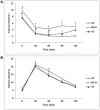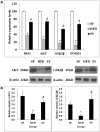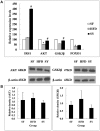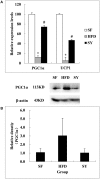The Mechanism by Which Safflower Yellow Decreases Body Fat Mass and Improves Insulin Sensitivity in HFD-Induced Obese Mice
- PMID: 27242533
- PMCID: PMC4876777
- DOI: 10.3389/fphar.2016.00127
The Mechanism by Which Safflower Yellow Decreases Body Fat Mass and Improves Insulin Sensitivity in HFD-Induced Obese Mice
Abstract
Objectives: Safflower yellow (SY) is the main effective ingredient of Carthamus tinctorius L. It has been reported that SY plays an important role in anti-inflammation, anti-platelet aggregation, and inhibiting thrombus formation. In present study, we try to investigate the effects of SY on body weight, body fat mass, insulin sensitivity in high fat diet (HFD)-induced obese mice.
Methods: HFD-induced obese male ICR mice were intraperitoneally injected with SY (120 mg kg(-1)) daily. Eight weeks later, intraperitoneal insulin tolerance test (IPITT), and intraperitoneal glucose tolerance test (IPGTT) were performed, and body weight, body fat mass, serum insulin levels were measured. The expression of glucose and lipid metabolic related genes in white adipose tissue (WAT) were determined by RT-qPCR and western blot technologies.
Results: The administration obese mice with SY significantly reduced the body fat mass of HFD-induced obese mice (P < 0.05). IPITT test showed that the insulin sensitivity of SY treated obese mice were evidently improved. The mRNA levels of insulin signaling pathway related genes including insulin receptor substrate 1(IRS1), PKB protein kinase (AKT), glycogen synthase kinase 3β (GSK3β) and forkhead box protein O1(FOXO1) in mesenteric WAT of SY treated mice were significantly increased to 1.9- , 2.8- , 3.3- , and 5.9-folds of that in HFD-induced control obese mice, respectively (P < 0.05). The protein levels of AKT and GSK3β were also significantly increased to 3.0 and 5.2-folds of that in HFD-induced control obese mice, respectively (P < 0.05). Meanwhile, both the mRNA and protein levels of peroxisome proliferator-activated receptorgamma coactivator 1α (PGC1α) in inguinal subcutaneous WAT of SY group were notably increased to 2.5 and 3.0-folds of that in HFD-induced control obese mice (P < 0.05).
Conclusions: SY significantly reduce the body fat mass, fasting blood glucose and increase insulin sensitivity of HFD-induced obese mice. The possible mechanism is to promote the browning of subcutaneous WAT and activate the IRS1/AKT/GSK3β pathway in visceral WAT. Our study provides an important experimental evidence for developing SY as a potential anti-obesity and anti-diabetic drug.
Keywords: PGC1α; insulin sensitivity; insulin signaling pathway; obesity; safflower yellow (SY).
Figures





References
-
- Barbatelli G., Murano I., Madsen L., Hao Q., Jimenez M., Kristiansen K., et al. . (2010). The emergence of cold-induced brown adipocytes in mouse white fat depots is determined predominantly by white to brown adipocyte transdifferentiation. Am. J. Physiol. Endocrinol. Metab. 298, E1244–E1253. 10.1152/ajpendo.00600.2009 - DOI - PubMed
-
- Choi C. S., Savage D. B., Abu-Elheiga L., Liu Z. X., Kim S., Kulkarni A., et al. . (2007). Continuous fat oxidation in acetyl-CoA carboxylase 2 knockout mice increases total energy expenditure, reduces fat mass, and improves insulin sensitivity. Proc. Natl. Acad. Sci. U.S.A. 104, 16480–16485. 10.1073/pnas.0706794104 - DOI - PMC - PubMed
-
- Collins S., Daniel K. W., Petro A. E., Surwit R. S. (1997). Strain-specific response to beta 3-adrenergic receptor agonist treatment of diet-induced obesity in mice. Endocrinology 138, 405–413. - PubMed
LinkOut - more resources
Full Text Sources
Other Literature Sources
Research Materials
Miscellaneous

